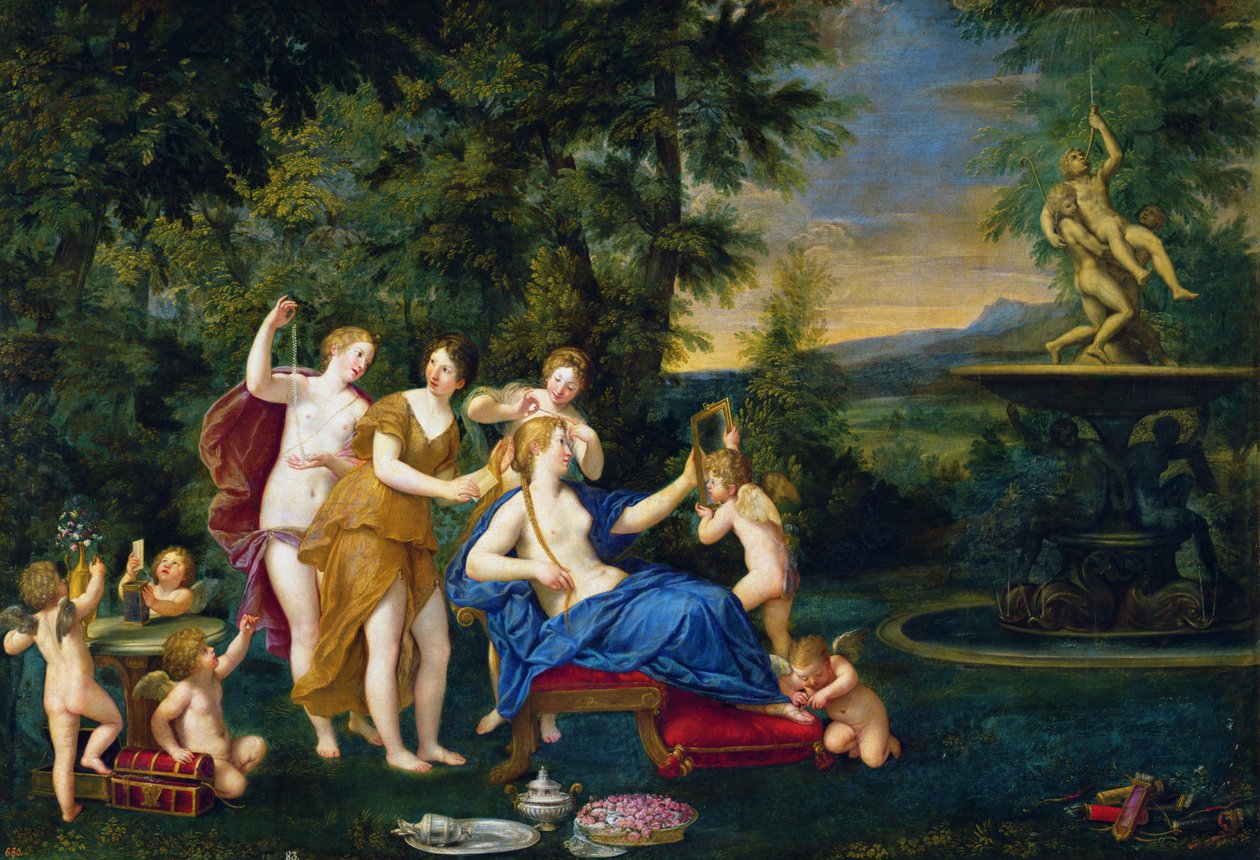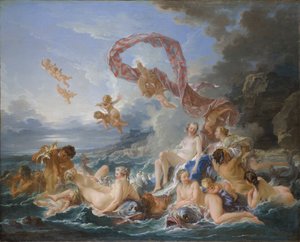1633 · Öl auf Leinwand
· Picture ID: 272195
Classicism
· Mixed Nudes and Eroticism
With the painting "Venus, accompanied by nymphs and cupids" from the year 1633, the painter Francesco Albani combines the Christian traditions of the Renaissance, epitomizing rebirth, with the classicistic views of both Greek and Roman art history and mythology. A pioneering mural concept forms the Bologna School, a style of Italian painting with a focus on classicism and its erotic to idyllic seeming figure and form diversity. In view of this, the figurative selection of the painting is cheerful and poetically permeated by natural cheerfulness and grace. As far as the choice of color is concerned, the picture speaks of the context of the Renaissance and its colorful effect. But let's take a closer look at the picture.
First of all, as far as the title of the picture is concerned, this is precisely in the frame of figuration. Venus, the Roman goddess of love and erotic desire, lies nude and half naked on a throne-like red armchair or couch. The central arrangement of central perspective design is completed by a fine cloth made of heavy brocade and their contemporary physique highlighted by the prevailing ideal of beauty. In their immediate vicinity are Cupids, that is, winged multiple representations of the love god Eros, who also bears the nickname Cupido as a personification of erotic desires. However, Eros also wears a quiver of arrows to the cupid in Roman mythology, which, when struck in the heart, awakens the love of the person concerned. His mischievous and sometimes boyish appearance is expressed concretely by playfulness and in many ways resembles angelic representations from the Christian tradition. Like Amor and Eros, Venus is the Roman equivalent of the Greek goddess Aphrodite. With her feet outstretched, she gets her feet pedicured by a cupid. In contrast, three nymphs stand behind her and take care of her hair. Her sister-like appearance corresponds in her physique Venus, who follows their work by a mirror in the left hand. Nymphs are constant companions of some gods, nature spirits and deities of a lower rank, which are associated with groves, meadows, springs and other natures. Filigree, her body is also wrapped in cloth that partially or fully covered her body. Three other cupids stand and sit at a table on the left, where they hand out jewelery and ornamental borders as jewelery for the goddess, the nymphs from a jewelry chest.
Scenically, the figures are found in a southern-looking meadow grove, which is surrounded by numerous trees (probably larch and pine trees). In the back course opens the thicket and shows a mountain landscape during a rising or setting sun. Something in the shadow are therefore rear areas, centered on a right-side fountain. On the fountain is a sculpture of the Greek shepherd god Pan, a horned hybrid creature carried by youths. As a god of the forest and nature, he lies a wind instrument playing on their hands. As a still life are in addition to the jewelry for Venus in the foreground two carafes and a bowl of silver with sweet delicacies. The discarded quivers, as well as the arrows and bows of the little cupids are also lying on the left front side in the grass. By incident light, coming from the upper left corner, the skin of Venus and the nymphs looks almost white. In contrast, the environment captivates with pure natural colors that are based on reality. If the capes of the nymphs in ocher and brown are relatively reserved and discreet, the throne, with its radiance in red, refers to the religious bond of period-typical Renaissance paintings. Here the color presents the Holy Spirit as well as the blood of the martyrs. Blue, on the other hand, in the form of the ultramarine, was gold in value and represents the celestial and the dominion. In combination with the white goddess skin, the purity of infinity is underlined again.
Stunningly designed in terms of color, the picture plays with the beauty of female bodies, which can be equated with universal love through the goddess Venus as a symbol of feminine grace. The playfulness of adolescent infatuation is stopped in its vicinity as well as the naturally arising desire. Rather, Venus is honored as the epitome of love, which extends to veneration as a parent. Love is the center.
Venus attended by nymphs and cupids by Francesco Albani. Available as an art print on canvas, photo paper, watercolor board, uncoated paper or Japanese paper.
braid ·
plait ·
sandal ·
casket ·
fountain ·
toilet
· Prado, Madrid, Spain / Bridgeman Images
|
×




.jpg)
.jpg)
.jpg)
.jpg)
.jpg)
.jpg)
.jpg)
.jpg)
_-_Renaud_presentant_un_miroir_a_Armide_-_Rinaldo_presents_-_(MeisterDrucke-1540735).jpg)
.jpg)
.jpg)
.jpg)
.jpg)
.jpg)
.jpg)
_-_Venus_and_Mars_-_(MeisterDrucke-1395581).jpg)
.jpg)
.jpg)
.jpg)
.jpg)
.jpg)
.jpg)
.jpg)
.jpg)
.jpg)
.jpg)
.jpg)
_-_(MeisterDrucke-588233).jpg)
.jpg)
.jpg)
.jpg)
.jpg)
.jpg)
.jpg)
.jpg)
.jpg)
.jpg)
.jpg)
.jpg)
.jpg)
.jpg)
.jpg)
.jpg)
.jpg)
.jpg)
.jpg)
.jpg)
.jpg)
.jpg)
 - (MeisterDrucke-43665).jpg)

.jpg)
.jpg)
.jpg)
.jpg)
.jpg)
.jpg)
.jpg)
.jpg)
.jpg)
.jpg)
.jpg)
.jpg)
.jpg)
.jpg)
.jpg)
.jpg)
.jpg)
.jpg)
.jpg)
.jpg)
.jpg)
.jpg)







